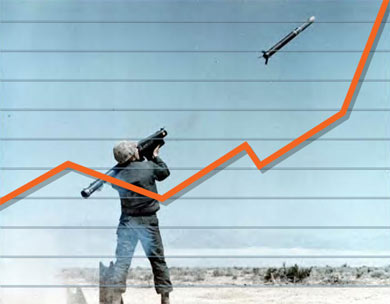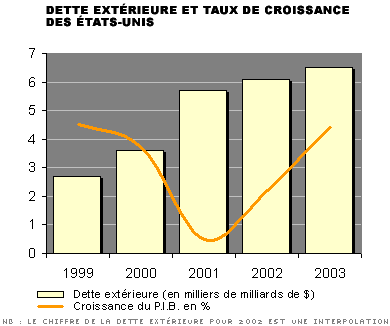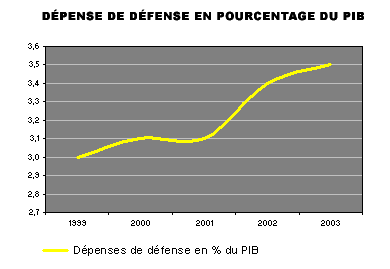The self-satisfaction statements on the outstanding economic growth issued by the Bush Administration are false. Actually, unemployment has increased, domestic production is collapsing and the economy is completely immersed into war. The foreign debt reaches critical levels, which is unprecedented for an industrialized country and, according to the International Monetary Fund, it poses a threat to the world economy. The specialization of arms industries makes it impossible to return to a peace economy. The U.S. has entered an infernal cycle in which the survival of its economy depends upon the continuation of the war.

By the end of 2003, the Department of Commerce made public its final estimate on the United States’ growth: a leap of an 8.2% of the gross domestic product (GDP) during its third quarter. 19 years has passed since the country last registered such a remarkable growth. The media welcomed unanimously "the return of America’s growth". However, some analysts were not enthusiastic about this because unemployment had risen between the year 2000 and 2003 (4.0% in 2000; 4.8% in 2001; 5.8% in 2002; and 6.1% in 2003). But, two important facts rapidly came up.
The growth is linked to the huge debt of the country and the transfer of social costs to the military sector. The American economy is now war oriented.

Growth based on credits
The U.S. has financed its growth through its debts. In 2002, the country had its first budget deficit since 1997. This rate has increasingly grown from 1.5% in 2002 to 3.5% in 2003 and is expected to reach 4.2% in 2004. In terms of comparison, the budgetary stability pact of the Euro zone sets a 3% limit.
The foreign debt - which was 3. 6 billion dollars in year 2000 (39% of the GDP) - grew 6.5 billion dollars in 2003 (58% of the GDP). A worrying assessment made by the Congressional Budget Office indicated that there will be a 14 billion dollars debt within the next ten years. The former Secretary of the Treasury, Paul O’Neill, conducted a survey on his own and showed that the U.S. deficit in the next 50 years will be 44 billion dollars.
On January 7, 2004, the International Monetary Fund (IMF) held a press conference on the fiscal policies of the United States and its consequences for the world economy [1]. Even though it was created and highly manipulated by Washington, the IMF came up with a number of accusations against the economic policy of Bush Administration. According to the IMF, the U.S. foreign debt has reached an unprecedented level for an industrialized country which indeed raises the interest rates while holding back the world growth.
Plundering, the only strategy to debt
By looking at the dramatic debt growth (which considerably exceeds the solvency of the country), Roberto Freeman questions the economic orientation of the Bush Administration. Freeman indicates there are five possible strategies [2] First: to raise taxes and pay the installments. But it is obvious that the Bush Administration has not considered this option. Second, to print off dollars. Though abusing this option would cause an inevitable collapse of the economy.
The third strategy is the one the IMF proposes to the Third World: to privatize the national assets and sell them to foreigners. This option is unlikely. However, by devaluating the dollars, the Bush Administration favors not only the exports but also facilitates the foreign companies to purchase American enterprises.
Fourth: refusal to pay the debt, as the Bolshevik did when they took power in Russia. For Robert Freeman, this option is «closer to what most Americans have in mind». In fact, a significant part of the deficit has to do with the funding of Social Security whose privatization will be one of Bush’s priorities if he wins the elections in 2004.
It seems that the Bush Administration has chosen the fifth strategy. As Robert Freeman states: «Plundering is still an option. When the reimbursement of the debt of a nation is so important that it is impossible to cool down the creditors, it must find a source of wealth, no matter what». The reason why the U.S decided to attack Iraq has nothing to do with the weapons of mass destruction or democracy. Its objective was to control oil, particularly, its international market.
An economic growth dependent on military expenditures
Facts confirm Robert Freeman’s analysis: under Bush’s Administration, the U.S. economy has been oriented towards war and conquest. The government justified the increase of the budget deficit through the war against terror. Such justification allowed the administration to use the social infrastructure funds as war expenditures. Military expenditures increased from 3.1% of the GDP in 2001 to 3.4% in 2002 and 3.5 in 2003.
The growth of these public expenditures benefited the private companies which produce weapons. The sales of Northrop Grumman registered a rise of 57% in the prices between 2002 and 2003 and the company which had a debit balance became a very profitable one. Boeing’s military division had a benefit of 38%. The amount of business of Lockheed Martin, world leader in the war industry, had 23% growth while the sales of its aviation division increased 60%.
However, according to Robert Pollin, professor of economics at Massachusetts University, the labor and armament costs were still relatively low. The biggest part was taken by Halliburton, Bechtel and some other private groups linked to Bush Administration.
Such growth which is highly welcomed by analysts has to do mainly with war investment. During the second quarter of 2003, in the middle of the war against Iraq, about 60% of the growth rate was due to military expenditures [3].

The new economic orientation of U.S. towards war and conquest has its bases in the refusal to sign the Ottawa Treaty on the prohibition of antipersonnel mines, the war against Iraq, the "star war" military project and the never ending war against terror.
In the last century, the shift of a war economy into a peace economy was extremely difficult. The change of a military industry was a delicate matter. Today, due to the level of sophistication of weapons, it is impossible. Therefore, the economic orientation chosen by the Bush Administration has no way back. For the U.S., war means economic survival.
[1] Elizabeth Becker and Edmund L. Andrews: «I.M.F. Says U.S. Debts Threaten World Economy», New York Times (United States), January 8, 2004
[2] How Will Bush Deal With the Deficits? Connecting the Dots to Iraq
[3] « How the War Machine is Driving the US Economy », par Andrew Gumbel, The Independent (Royaume Uni), 6 janvier 2004

















Stay In Touch
Follow us on social networks
Subscribe to weekly newsletter